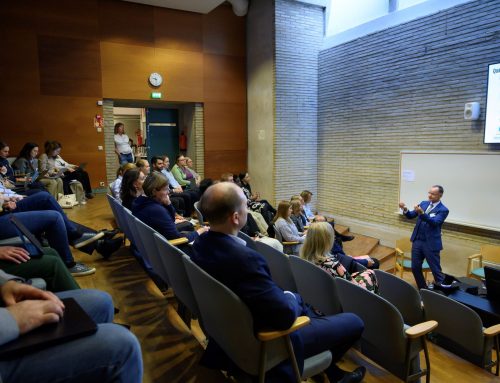I have spent a month on a research visit at the Swedish School of Textiles in Borås. With the time spent in the university environment which is fully dedicated to textiles some reflections emerged. I want to share them with you.
The research visit to the School of Textiles taught me a lot about textiles at different stages of their lifetime, from production, fashion marketing and consumption, to reuse, repurposing, and recycling. The way the school is organized gave me the impression of a university-scale textile ecosystem. The shelves in the corridors have books about fashion and costume. Students can work with machines to produce their own textiles and decorate them. A spacious lab was spotted, and it serves as an incubator for great ideas. I also visited local fashion retail shops and charity second hands in Borås.
Picture 1: Artwork at the Swedish School of Textiles. Picture 2: New Look outfit from the Textile Museum


So, I reflected a lot on this topic. I realized that textiles are a (really) big part of our everyday life. Textiles are always there for you. You find those accompanying you in basic routines such as drying your sleepy face in the morning with a towel. But also, on fancy occasions when one needs an evening dress to feel confident and beautiful.
Maybe for that reason, textiles are such an obvious starting point when it comes to sustainable living. In fact, the textile industry is one of the largest polluters globally. Thanks to increasing transparency and pressure from environmental and social activists, we know more about who made our textiles and in which working conditions (terrible). We also observe a rising awareness of the industry’s impact on the labels of our “sustainably produced” fashion garments.
What did I learn during my visit to becoming a (more) sustainable consumer of fashion textiles? The first learning is that science indeed doesn’t always meet practice. When my suitcase barely passed the weight limit for the plane, a sustainability researcher inside me had an existential crisis. I know well about the impact of textiles, and I do research within the area of textile circularity. But I still have a suitcase full of clothing. How much textiles are enough? How do we make sure we only take those few textiles on a (lifetime) journey with us to minimize our footprint?
The textile museum located at the university shows its visitors the history of textile production in Sweden. Also in the university labs, I could see big bulky machines, kilometres of threads, and little cuts of fabrics. One can sense the focus and concentration needed to produce textiles. Inspiration for design and knowledge for smooth functionality. How could the effort it takes to produce garments become so unappreciated? I read that the average fashion consumer wears textile products around 3 times from the moment of purchase. Why do we let these efforts go to waste so fast and easily?
Picture 3: Old machine at the textile museum. Picture 4: The concept of renewed garments


Lastly, I thought about reuse and repair a lot. I also saw different concepts that would allow us to repair and sell repaired garments again. It reminded me of how my grandparents used to care for their clothing. It was fascinating: gentle handwash, carefully stored, sewing little holes, and making needed adjustments to prolong its use. I see so much love in repairing your favourite textiles. However, at the second-hand shops, I see plenty of nearly new, unused textiles. When did we lose our feelings to the things that we buy so they don’t stay with us for longer?
So, from these reflections, I have made a few conclusions. I think they can help to re-tune the existing consumerism mindset towards a caring and sustainable textile owner. 1) Less is indeed more. We can simplify our lives by owning less (or at least our suitcases will weigh less). Just by buying less amount of clothing, we can already reduce our footprint. 2) Your textiles are someone’s artwork and effort. Imagine meeting your clothing “creator”, the person behind the artwork. What would you talk about? How would that meeting change your perception of the textiles you own? 3) Maybe we need to let go of the concept of purchasing textiles. I decided that I own them now. The idea of ownership includes investing your time and money in maintenance and care. It also means transferring the ownership to another person when we are no longer able to care about them. Owning things means to me a deeper connection with your belongings, maybe even truly loving them – isn’t that a key to sustainability?
Anna Zhuravleva
PhD candidate




